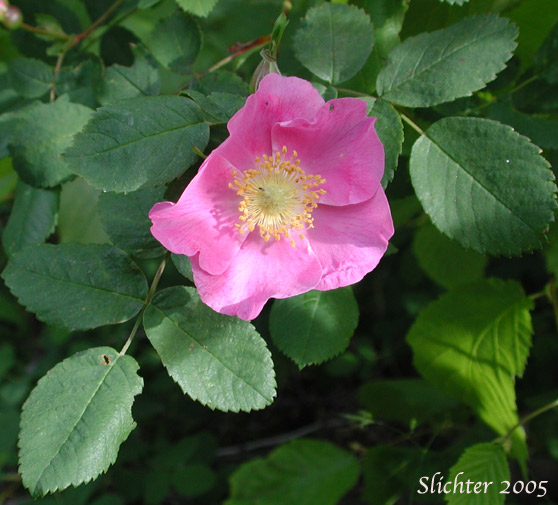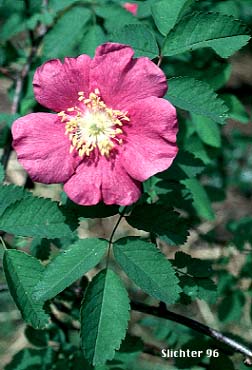

 The photo at right shows the
large flower of the Nootka rose.
The photo at right shows the
large flower of the Nootka rose.
The Nootka rose is an attractive shrub to 3 meters high. The stems are usually green, but occasionally may be reddish. The stems grow straight and erect, and are not intertwined as with the clustered wild rose. The prickles are curved backward and found in pairs below the stipules or leaf petioles. The prickles of this species are larger and thicker than those of the other native rose species.
The leaves are alternate on the stems and they are pinnately compound with 5-7 leaflets. The leaflets are dark green above and paler and slightly hairy below. The leaflets are elliptic or ovate in shape with serrate or doubly serrate margins, and range from 1-7 cm long and 0.7-4.5 cm wide.
The pink or rose-colored flowers are usually solitary, although 2-3 may be found at the ends of newer, prickleless side branches. The flowers are large sweetly scented, and showy, ranging from 5-8 cm across. Individual petals are 2.5-4 cm long, and 5 petals are the norm for the flowers. The rose hips are spherical, orange -red and large, ranging from 1-2 cm wide. The sepals and dried stamens remain attached to the tips.
1. Dried flower petals for scents, potpourri.
2. Rose hips are high in vitamin C, may be made into jam, tea, and used as flavoring.
3. The Nootka wild rose may be used as a hedgerow or as an ornamental.
4. Native Americans mashed the leaves together and made a poultice for application to sore eyes, abscesses, and bee stings.
5. The fruits are an important food source by various herbivores and upland game birds. The leaves and twigs are eaten by numerous browsers, and rose thickets provide excellent nesting and escape habitat for songbirds.
Nootka rose may be found in open upland woods or in open shrub wetlands. In areas where both Rosa nutkana and Rosa woodsii occur, the former may be found at higher elevations and often in woods. In areas where both Rosa nutkana and Rosa woodsii occur, the former may be found at higher elevations and often in woods.
Nootka rose may be found from Alaska south through British Columbia and west of the Cascades through Washington and Oregon to northern California. It may be found in northern Oregon to the Blue Mts, and in the Rocky Mountains of Colorado and Utah.
It may be found in the Columbia River Gorge between the elevations of 100'-4500' from the western approaches to the gorge to as far east as the Dallesport, WA.
A close-up of the fruit or rose hip of the Nootka rose is shown in the photo above. Note the sepals which persist on the hip.